Want to make your own podcast? Don’t get hung up on where to host it! Buzzsprout and Anchor are both platforms that empower you to share your podcast with the world.
This review is right for you if you’re undecided about which is better suited to your project! Here we’ll look at Buzzsprout vs Anchor and decide the advantages and drawbacks of both platforms and what hosting your content with them might mean for your podcast.
Intrigued? Good. Let’s get started.
What Are Buzzsprout and Anchor.fm?
As we just hinted at in the intro, Buzzsprout and Anchor are both platforms that enable you to:
- Host your podcast on their servers
- Create cover artwork for your podcast
- Distribute your content to a variety of podcast directories
In addition, they each provide a range of additional features, including listener analytics, mastering and recording tools, and monetization options.
Buzzsprout vs. Anchor: Key Services Compared
Buzzsprout and Anchor provide similar features, so we can go ahead and compare them directly:
Buzzsprout vs Anchor: Hosting
As we just said, both Buzzsprout and Anchor enable you to host your podcast online. For this purpose, your podcast will have its own landing page where different episodes are listed.
Both Buzzsprout and Anchor also provide unlimited storage space for your audio files and keep a complete history of your podcast episodes.
However, Buzzsprout limits how many hours of audio you can upload each month depending on the pricing plan you choose. Unfortunately, there's no plan with unlimited audio uploads per month.
In contrast, Anchor doesn’t impose such limits. But as a free service, Anchor’s hosting doesn’t provide as much freedom. For instance, with Buzzsprout, you can customize your landing page and host it on your own custom domain. Whereas, Anchor’s podcast page is much more limiting, as you can’t add your own domain.
Anchor vs Buzzsprout: Podcast Distribution
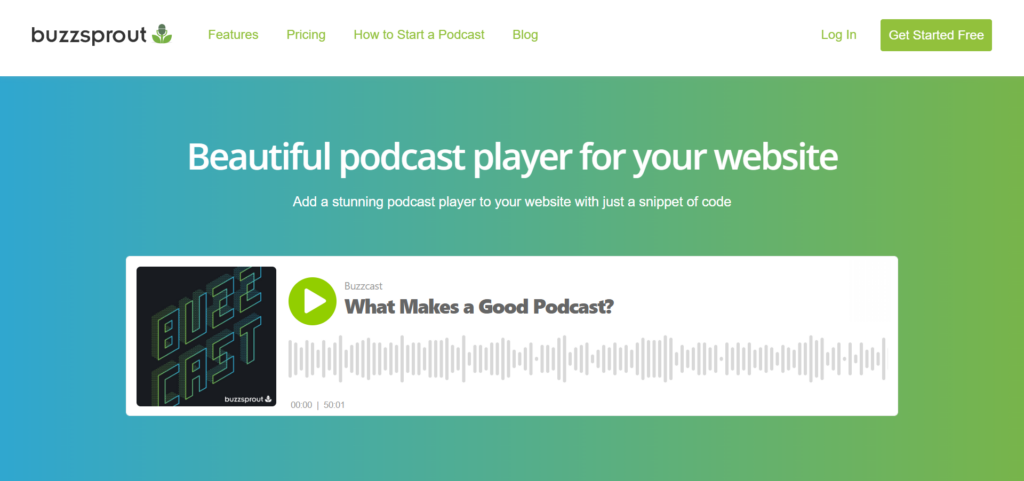
Your own landing page isn’t the only place your podcast should shine. That’s why Buzzsprout and Anchor enable you to share your podcast with a wide range of podcast directories.
Both providers have got you covered for:
- Apple Podcasts
- Spotify
- Google Podcasts
- Stitcher
- Pocket Casts
- Castbox
- Overcast
Buzzsprout additionally distributes to:
- TuneIn
- Alexa
- Castro
- Podchaser
- iHeart Radio.
Anchor, on the other hand, additionally covers Amazon Music and RadioPublic.
Your podcast first has to be submitted for a slot to be distributed to these platforms. Then, once it’s accepted, your podcast platform will automatically sync each new episode you upload to these podcast directories. With Buzzsprout, this process is manual. On the other hand, Anchor can automatically submit your podcast to these platforms to ensure coverage on as many compatible directories as possible.
Buzzsprout also makes sharing your podcast on social media and/or your own website easier and more attractive. It achieves this through “Visual Soundbites,” which display your podcast's audio waves and the cover art in an engaging podcast player. You can customize this to match your brand’s color. Unfortunately, Anchor doesn’t offer a similar feature.
Buzzsprout vs Anchor: Monetization
Once your podcast gains a following, chances are you’d like to see some revenue back for all your efforts. This is where podcast monetization comes in. Here, Buzzsprout and Anchor take very different approaches.
Buzzsprout enables you to connect with a range of affiliate programs so that you can collaborate with brands and advertise their products during your podcast. Then, if customers purchase from you, you’ll earn a commission.
Anchor doesn’t currently come with built-in affiliate programs. However, nothing is stopping you from finding sponsors on affiliate websites or getting in touch with brands directly.
However, even without this feature, Anchor takes monetization a step further. You can create podcast subscriptions where listeners pay a recurring fee to access your content. Various pricing structures are available, and you can email your subscribers directly. Unfrotaunetly, creating and selling subscriptions isn’t possible with Buzzsprout.
You can also opt into Ads by Anchor, which is Anchor’s own monetization platform. This empowers podcasters to create ads for Anchor in their own voice to earn alongside their podcast episodes. There are three types of ads you can create:
- Ambassador Ads: Podcasts with 50 regular listeners are eligible to create these ads. Here, you spread the word about Anchor to listeners in your own voice to earn extra cash.
- Automated Ads: Here, you can access ads from third-party brands. According to their relevant interests, these are targeted to listeners via the Spotify Audience Network. They're automatically inserted into ad breaks that you've scheduled into your content. Any creator can apply to participate in automated ads, but there’s currently a waitlist in the closed beta.
- Premium Sponsorships: Here, you’ll read ads for third-party brands. This is only available for listeners with very high engagement rates. You’ll be notified by the platform if you’re eligible.
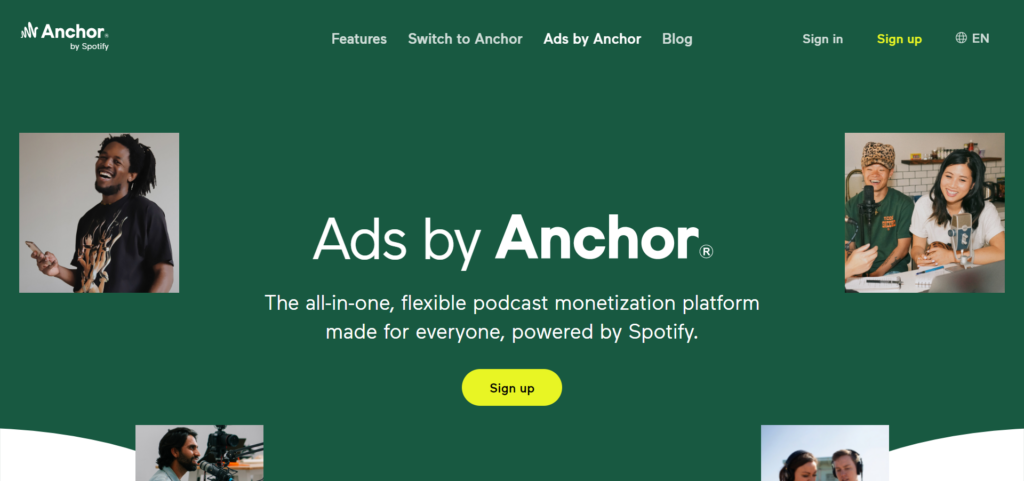
Anchor’s monetization method is simple and easily streamlined. Still, unless you boast very high engagement rates, you’re unlikely to make lots of money from it. On average, you can expect to be paid $15 CPM, which means per thousand downloads.
Buzzsprout is currently testing its own Ad monetization in beta, but this is still very new and prone to breaking. Ads are placed mid-rolls, come with eligibility requirements, and only currently serve to advertise other podcasts. Every ad downloaded pays $0.014.
Buzzsprout vs Anchor: Analytics
Analytics are vital for ensuring you know how your podcast’s performing and what you can do to improve in the future. Fortunately, Buzzsprout and Anchor have analytics functions and are IAB 2 certified, meaning their metrics adhere to industry best practices for podcasts.
Buzzsprout enables you to track your total downloads over time, what apps people use to listen to your podcasts, and where listeners are located. Furthermore, you can drill down into the stats provided by different directories on their respective platforms. Available statistics will depend on the directory but may include more in-depth engagement, drop-off, and listener stats.
Anchor provides similar data, with a little extra for Spotify listeners. Anchor tracks where Spotify listeners are dropping off during your podcast so you can quickly learn which segments are less interesting to your audience and plan new episodes around content that performs best. You can also review your audience demographics by age, gender, geolocation, and listening apps.
Buzzsprout vs Anchor: Recording and Mastering
Buzzsprout doesn’t come with podcast recording built-in. However, it provides a few neat tools for arranging and optimizing your episodes. For instance, you can add dynamic content to your podcast. I.e., you can add and remove pre-roll and post-roll segments to and from your episodes. This comes in handy for easily sending a message to all your listeners, regardless of which episode they’re on or when they’re listening.
Buzzsprout also automatically optimizes your episode files when you upload them. So you can rest easy knowing they’re in the right format and boast a high-quality regardless of file type, bitrates, or ID3 tags.
You can also opt into Buzzsprout Magic Mastering. This add-on service carries an additional fee and acts as an audio filter for your podcast, sweetening and optimizing the sound according to industry best practices. Beyond this, Buzzsprout offers no podcast recording or editing features.
In contrast, Anchor allows you to record on the go with any device. In fact, multiple people can record with you simultaneously to create podcasts with co-hosts and guests. Alternatively, you can invite them to send you a voice message or answer Q&As and polls. One drawback of its recording function is that it records in the M4A format. Unfortunately, this only translates into 32 bytes per second, thereby offering lower audio quality than what you might be aiming for.
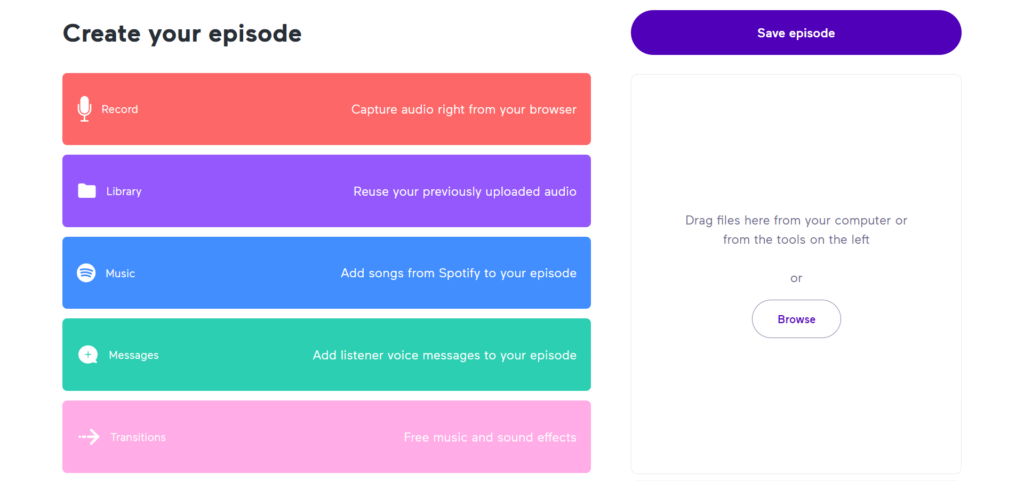
Once you’ve recorded an episode, you can rearrange segments and place advertisement slots amidst your content. You can also add any track from Spotify to your episodes to combine music and dialogue. However, its podcast editor is a little clunky and doesn’t offer additional features beyond cutting and rearranging your audio. If you’re hosting with Anchor, you’ll likely need to download more advanced podcast editing software.
Buzzsprout vs. Anchor: Pricing and Costs
Let's see how much Buzzsprout and Anchor will set you back…
Buzzsprout Pricing
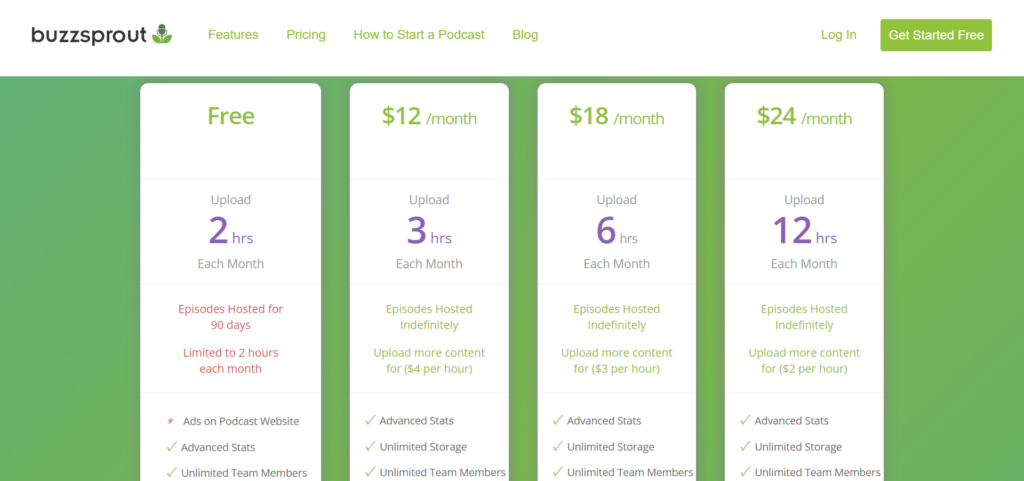
Buzzsprout indeed comes with a free plan. However, this is limited to uploading only two hours of content each month. Also, episodes are only hosted for 90 days. This is a significant limitation, considering you’ll want your podcast to stay online so that new listeners can catch up with your older content. There will also be ads plastered on your podcast’s landing page.
Every plan (including the free program) comes with:
- Advanced stats
- Unlimited team members
- A podcast landing page
- Custom embed players
- The ability to submit your podcast to podcast directories
After the free plan, the following paid plans are available and based on monthly billing:
- For $12 a month, you can upload three hours each month and host episodes indefinitely. You also gain unlimited storage and can import your podcast from another platform for free.
- For $18 a month, you get everything above, but you can upload six hours each month.
- For $24 a month, you get everything above, but you can upload 12 hours each month.
- You can add Magic Mastering to any premium plan for $6 per month, $9 per month, or $12 per month, respective to the pricing plan you’re on.
Those interested in transcribing their podcast can purchase this service for an additional $0.25 per minute.
Anchor Pricing
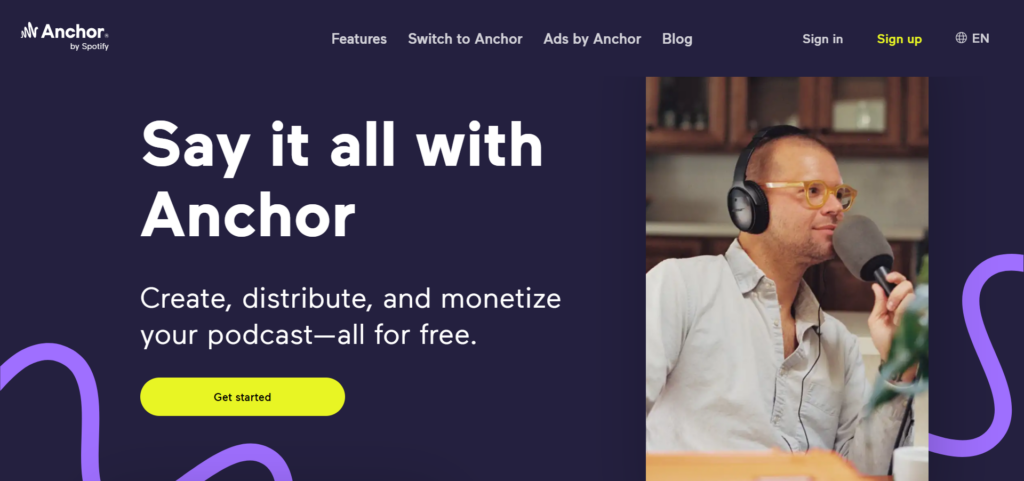
Anchor is an entirely free podcast hosting service! You’ll benefit from unlimited free hosting, with no cap on how many hours of podcast content you can upload.
Buzzsprout vs Anchor: Pros and Cons
Before we wrap up, to help condense all of the above info, below, we’ve listed Buzzsprout and Anchor’s key pros and cons:
Buzzsprout Pros and Cons
Pros 👍
- There’s a free plan available
- You can display visual soundbites on social media
- You benefit from various integrations, including Canva, Podtrac, Charitable, Alitu, WordPress, and more.
- A transcription service is available for an additional fee
- Access to a wide range of podcast directories
- Well-reviewed customer support with over 1,000 reviews on Trustpilot
- Customer service reportedly answers within 12 minutes (on average).
Cons 👎
- The free plan is minimal. It might suit beginners looking for a trial run, but anyone serious about podcasting will have to upgrade.
- There aren’t any recording or podcast editing tools available.
- Its Magic Mastering add-on comes at an additional price.
- Monetization options are pretty limited, though a beta version of Buzzsprout Ads is in the works.
Anchor Pros and Cons
Pros 👍
- Anchor actually submits your podcast to podcast platforms on your behalf. That way, you can efficiently distribute your project across a broader market.
- It comes with podcast recording and editing tools and access to Spotify music.
- You get access to more in-depth analytics for Spotify.
- Anchor’s monetization tools are better established and easy to use
- Its completely free to use, with unlimited podcast uploads and storage
- Access to 24/7 support
Cons 👎
- When uploading to Apple Podcasts, proceed with caution. If Anchor submits your podcast, it will be listed under Anchor’s own account. Plus, you won’t have access to Apple Podcasts' stats.
- Its monetization tools are only available in the US.
- The episode editor is a little clunky, so you’ll still likely need more advanced third-party software.
Buzzsprout vs Anchor: Our Final Verdict
Both Buzzsprout and Anchor have a lot going for them regarding podcast hosting, so choosing between them isn’t easy.
With Buzzsprout, you get a little more control over the presentation of your content, benefit from automatic file optimization, and can add dynamic content to your episodes.
In contrast, Anchor is much more Spotify-focused. But permits less ownership over your podcasts. However, it’s entirely free, comes with recording and editing tools, and has a better-established monetization program for US users.
The best podcast hosting option for you will depend on your priorities. That said, new podcasters are probably better served with Anchor’s free service. They can see how their listener base grows over time without any initial financial investment. After all, it’s always possible to migrate your content to Buzzsprout later.
What do you think? Which will you go for? Or are you considering alternative podcast hosting services like Podbean, Blubrry, Simplecast, or Libsyn? Let us know in the comments below what’s most important to you in a podcast hosting platform. Speak soon!




Comments 0 Responses